| Renaissance ITALY |
 |
Girolamo Savonarola
- Renaissance Italian religious and political reformer, Girolamo Savonarola, was born into nobility at Ferrara. In 1474 he entered the Dominican order at Bologna. He preached in 1482 at Florence but failed, but in 1489 he returned. His second appearance in the pulpit of San Marco, on the sinfulness and apostasy of the time, was a triumph, and he was hailed as an inspired prophet. His preaching pointed to a political revolution as the divinely-ordained means for religion and morality. The republic of Florence was a Christian commonwealth. Stringent laws repressed vice and frivolity. Gambling was prohibited an the vanities of dress were restrained by laws. Women flocked to the public square to toss aside their costliest ornaments. Savonarola's followers made huge "bonfire of the vanities." |
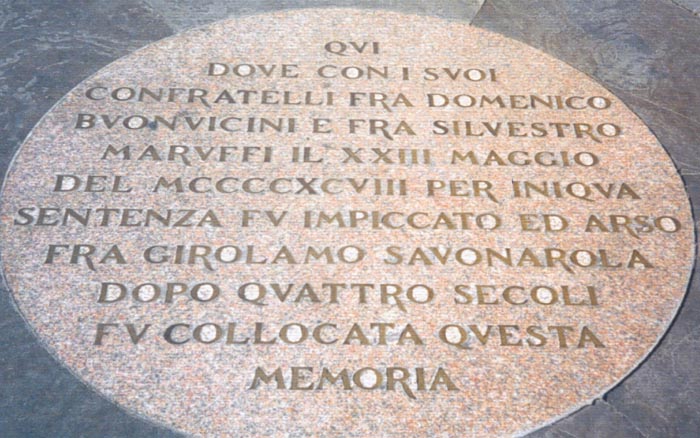 |
Girolamo Savonarola
- Renaissance His claim to the gift of prophecy led caused him in 1495 to answer a charge of heresy at Rome. Savonarola disregarded the order. In 1497, he was excommunicated from Rome. He held a second "bonfire of the vanities". but in 1498 this led to riots. The Medici came into power and Savonarola was ordered to desist from preaching and was denounced by a Franciscan preacher, Francesco da Puglia. Dominicans and Franciscans appealed to the interposition of divine providence by the ordeal of fire. But when the trial was to have come off (April 1498) difficulties and debates arose, destroying Savonarola's prestige and producing a complete revulsion of public feeling. He was brought to trial for claiming to have seen visions, and uttered prophecies, for religious error, and for sedition. On May 23, 1498, he was hanged and burned. |
 |
Palazzo Vecchio - Renaissance
Palaza Vecchio meaning "Old Palace" - The Palazza Vecchio is attributed to Arnolfo di Cambio who began it in 1299, incorporating the ancient tower of the Foraboschi into its construction. After the death of Arnolfo in 1302, the palace was finished by other artists in 1314. |
 |
Palazzo Vecchio - Renaissance
The solid cubical shaped Palazzo Vecchio is enriched by the thrust of the simple tower with its precious Lederle clock with terminates on high with the bell-tower surmounted by the cusp and the lively lion rampant. In this public palace built as the seat of the Priori, later lived the Duke of Athens, who was driven out because of his tyranny. From 1540 to 1550 it was the home of Cosimo I who enlarged the construction. When Cosimo moved to the Pitti Palace this palace was identified with the name "vecchio" (old) to distinguish it from the new (Pitti) and this name remained. From via Gondi the additions of the Palazzo Vecchio, executed in the XVI and XVII centuries are visible. |
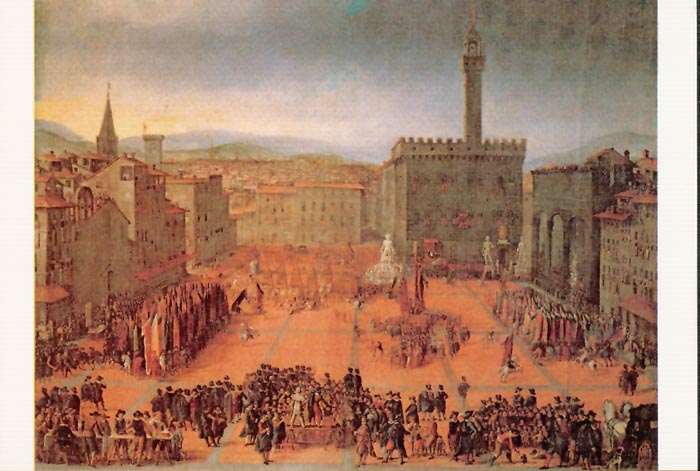 |
Piazza Della Signoria
- Renaissance This plaza is at the heart of the origin and history of the Florentine Republic. The square conserves its character as the political center of the city. The square is dominated by the 14th century Palazzo Vecchio with the bold crenellated tower. On the right you can see the Uffizi Gallery, and the Loggia della Signoria. On the left the Palace of the Tribunale della Mercanzia (commercial court). |
 |
Piazza Della Signoria
- Renaissance You can see many statues in the square, from left to right, The bronze equestrian statue of cosimo I by Giambologna (1594), with episodes of his reign. Next, the Fountain of Neptune called by the Florentines "Biacone" by Ammannati. The base of the fountain has interesting bronze figures of nymphs and satyrs, by collaborators of Ammannati, among whom was Giambologna. Near the center of the square a porphyry plaque commemorates the site where Savonarola and his followers Maruffi and Buonvinini were hanged and burned at the stake. on the steps of the Palazzo Vecchio: the Lion called "il Marzocco" with the Florentine Lily, a copy of an original by Donatello in the National Museum. on the granite pedestal, Judith slaying Holofernes in bronze, a dramatic work of Donatello's maturity. Near the entrance of the palace, a copy of David that substitutes the original by Michelangelo, conserved in the Gallery of the academy of fine arts. Followed by the heavy marble group of hercules and Cacus, by Bandinelli (1533). At the entrance of the Palace the two statues at one time served to hold the chains that blocked the door. The female statue on the right is by Bandinelli while the male on the left is by Vincenzo de'Rossi. |
 |
Piazza Della Signoria
- Renaissance This was a colorful musical outdoor performance in the Piazza Signoria. |
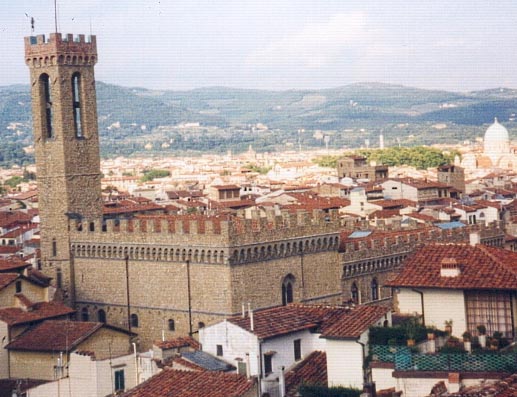 |
Palace of the Bargello
- Renaissance Palace of the Bargello - a Fortress-Palace, it was begun in 1255 as the seat of the Captain of the People. The architect of this building, still unknown, incorporated into the palace the existent embattled tower of the "Volognana" with its historic bell that announced the capital punishments with its dismal toll, and thos now rings on the occasions of national or local holidays. From 1261 the palace was the seat of the Podesta, the magistrate whose role was to maintain equilibrium between the parties , and later of the Guidici di Rota. |
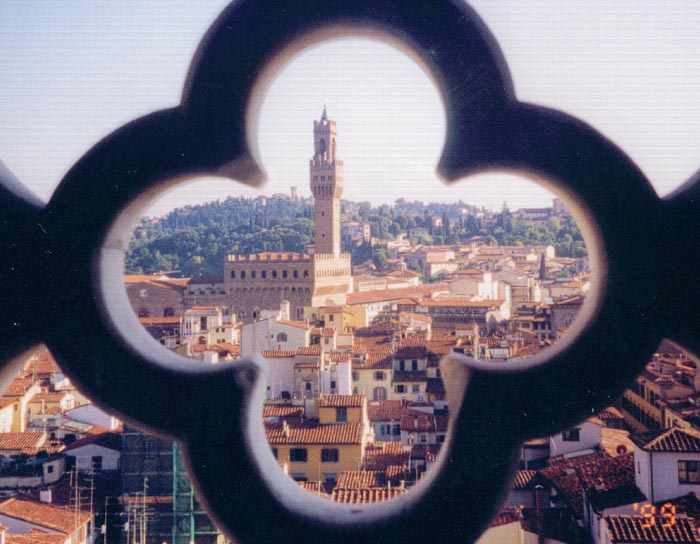 |
Palace of the Bargello
- Renaissance From 1574, the Bargello was the seat of the Bargello or Captain of Justice. In this period, the interior of the Palace was transformed into squallid and harsh prisons, located on the ground floor, in the Loggia and the salone (Great Hall), then divided maong 4 floors with more than 30 cells. At the time of the podesta, the Hall was the seat of the General council. It is now dedicated to Donatello and contains masterpieces of 15th century Florentine sculpture. The room on the ground floor was once used for torture. The prisoners were forced to confess by the use of cruel and horrible instruments of torture. Grand Duke Peter of Lorraine abolished these infamous abuses of Justice, the sad prison cells, the scaffold, the instruments of torture that historians remember with horrifying description. |
 |
San Marco Church
- Renaissance Cosimo the Elder restores the San Marco Church. He was a banker and politician of vast foresight who protected monastic orders. In 1449 Beato Angelico in 1449 was named Prior of San Marco. Some of Giotto's works are at the San Marco Church. |
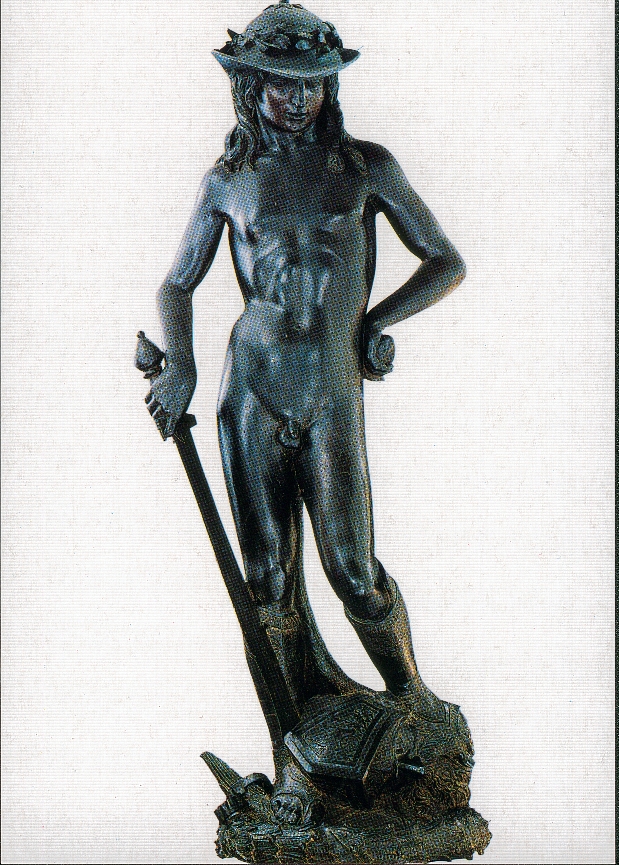 |
Donatello's Young David
- Renaissance This is a Bronze Statue of the "Young David" by Donatello |
 |
Gallery of the
academy of fine arts - Renaissance A blurb about "The David" by Michelangelo in The Gallery of the academy of fine arts. |
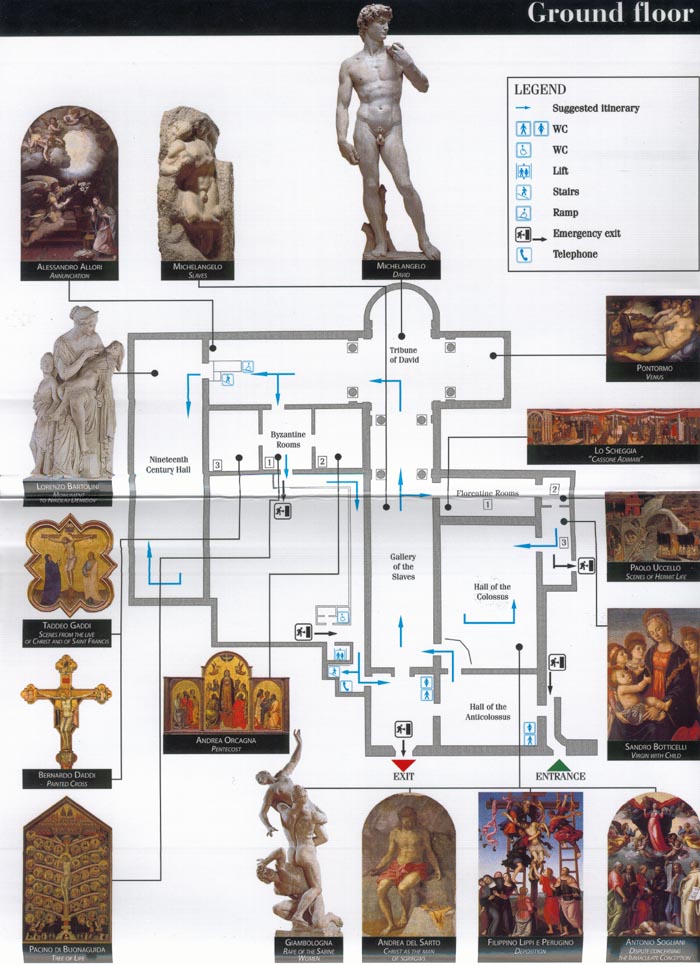 |
Gallery of the
academy of fine arts - Renaissance A map of The Gallery of the academy of fine arts. |
 |
Gates of Paradise
- Renaissance This is the Bronze doors of the Baptistry called "The Gates of Paradise." They were crafted by Lorenzo Ghiberti. It took him over 20 years to craft these 20 panels. His doors are said by some to mark the beginning of the Renaissance. The Baptistry is dedicated to St. John the Baptist, the patron of the city. The Romanesque building of the 11th century covered with white and marble, is enriched by three magnificent bronze doors. |
 |
Gates of Paradise
- Renaissance This is a closeup of one of the Bronze panels from the Gates of Paradise. |
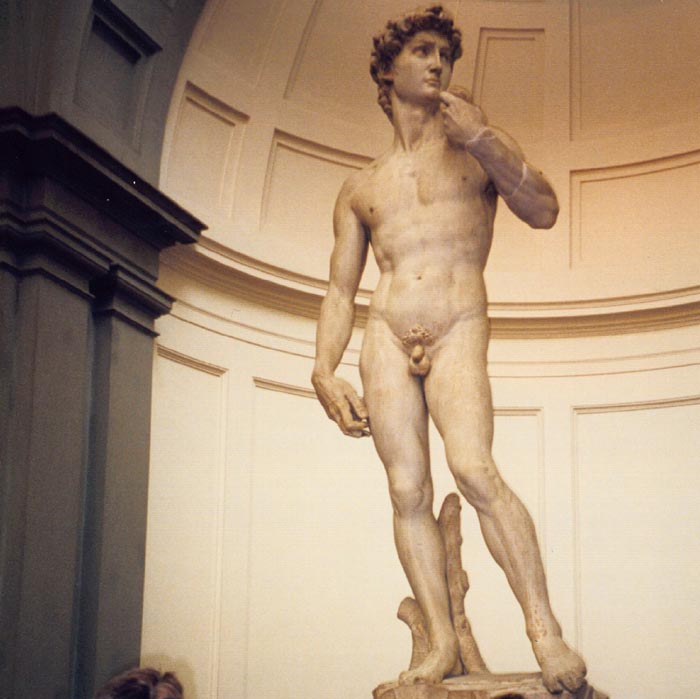 |
Michelangelo's David
- Renaissance The Statue of David by Michelangelo is one of the most famous statues in the world. In 1501, Michelangelo was commissioned to create the David by the Arte della Lana (Guild of Wool Merchant). He was given a block of marble which Agostino di Duccio had already attempted to fashion forty years previously. Michelangelo breaks away from the traditional way of representing David. Not present as the winner with the giant's head at his feet and the sword in his hand. Rather, he portrays David as tense with a sense of power immediately preceding the battle with Goliath. Michelangelo places him in the perfect contraposto, as in the Greek representations of heroes. The right-hand side of the statue is composed while the left-hand side, from the outstretched foot all the way up to the disheveled hair is active and dynamic. The muscles and the tendons are developed as the perfect instrument for a strong will. Once the statue was completed, a committee of the highest ranking citizens and artists decided that it must be placed in the main square of the town, in front of the Palazzo Vecchio, the Town Hall. It was the first time since antiquity that a large statue of a nude was to be exhibited in a public place. Strength and Wrath were the two most important virtues, characteristic of the ancient patron of the city Hercules. Both these qualities of passionate strength and wrath were embodied in the Statue of David. |
 |
Church of Orsan Michel - Renaissance The Church of Orsanmichele - It was the former oratory of San Michele in Orto. In 1290 Arnolfo di Cambio built the Loggia del Grano (Grain Market), destroyed by a fire in 1304. The cube shaped church, typical of Florentine gothic was built by Francesco Talenti and Neri di Fioravanti, who built the grain lodge in the upper floors, in case of famine or siege of the city, now a hall used for periodic expositions by the Superintendant of Arts. Each of the arches on the ground floor contains statues of the patron saints of the Florentine guilds. They are (1) Tabernacle of Mercanti di Calimala (Wool merchants) (2) Tabernacle of the tribunal of the Merchants (3) Tabernacle of Judges and Notaries (4) Tabernacle of Butchers (5) Tabernacle of Tanners guild : St Philip (6) Tabernacle of the Carpenters and Masons (7) Tabernacle of the Amourers and Sword makers (8) Tabernacle of the Moneychangers (9) Tabernacle of the Wool Workers (10)Tabernacle of the Blacksmiths (11) Tabernacle of the Linen Workers (12) Tabernacle of the Furriers (13) Tabernacle of the Doctors and Apothecaries (14) Tabernacle of the Silk workes and Goldsmiths |
 |
Strozzi Palace - Renaissance The Strozzi Palace - begun by Benedetto da Maiano, for Filippo Strozzi, an unfortunate rival of the Medici. It is a splendid example of civil architecture with its rusticated stone, inspired by the Medici-Riccardi Palace,but with more harmonious proportions. the palace has beautiful mullioned windows and a magnificent cornice, typical of Florentire palaces of the time, left incomplete by Cronaca, who continued the construction of the palace until 1507. Also by Cronaca is the beautiful courtyard, inspired by Michelozzo. the famous wrough-iron lanterns that decorate the corners of the palace exterior, are by the bizarre and able artisan, Caparra. |
 |
Piazza del Michelangelo
- Renaissance This is renowned as one of the most panoramic sites of Italy. It commands a superb view of the city and the hills of Fiesole. It is a short bus ride from downtown Florence, you can look down upon the various bridges and the Arno River which flows towards Pisa, flanked in distance by the famous Cascine Park. |
 |
Piazza del Michelangelo
- Renaissance To the left of the Piazza are the picturesque walls of San Giorgio and the Belvedere Fortress. In the center of the Piazzale is a bronze copy of Michelangelo's David and bronze copies of his statues of Night, Day, Dusk and Dawn, the originals of which are in the Medici Chapels. |
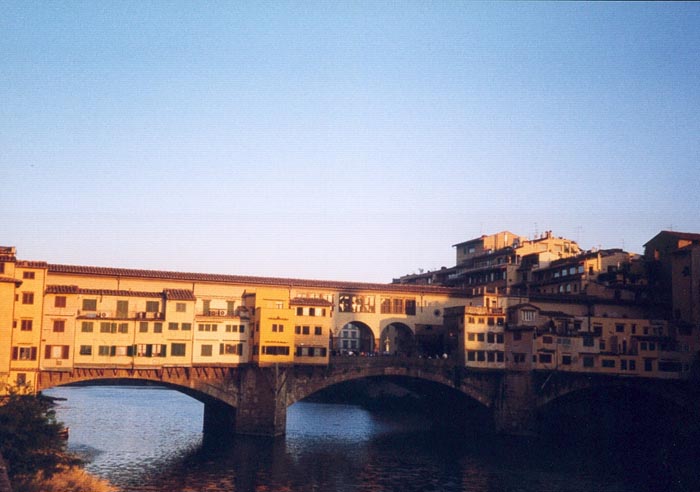 |
Ponta Vecchio - Renaissance Attributed to Neri di Fioravanti (1348), who replaced an old wooden bridge destroyed by the flood of 1333 (it was damaged in 1944 by the retreating Germans and by the flood of Nov. 4, 1966). The Ponte Vecchio (meaning Old Bridge), with its small characteristic shops is known throughout the world as the jewellers' bridge; formerly there were butcher shops. |
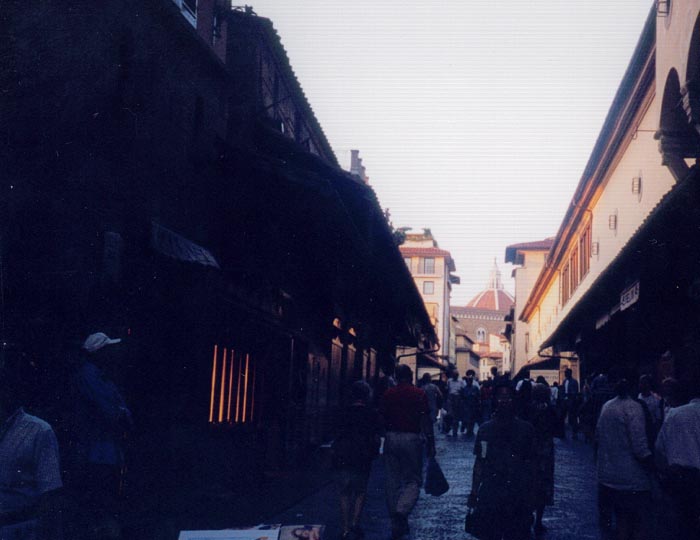 |
Ponta Vecchio - Renaissance On the terrace is a square-based monument surmounted by a bust of Cellini by Romanelli (1900). Above the shops on the left hand side, is the Vasarian Corridor that joins the Uffizi Gallery to the Pitti Palace. After the Ponte vecchio beings via Guicciardini, rebuilt after the war. Inside the famous Deposition by Pontormo is in the first chapel on the right. The upper balcony was used by the Grand Dukes of Lorraine when they came from the Pitti Palace for their religious services. Continuing along Via Guicciardini, at no. 18 is a plaque marking the house in which Machiavelli lived. Ahead on the left is the Guicciardini Palace with its beautiful garden, attributed to Baccio d'Agnolo. |
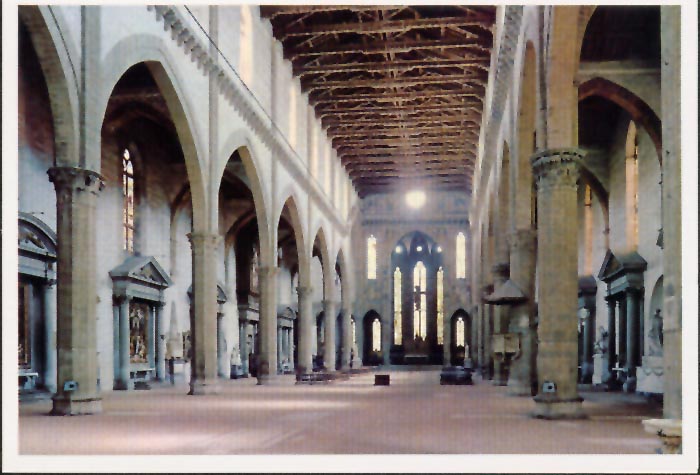 |
Church of Sante Croce - Renaissance The church of Santa Croce - was begun by Arnolfo in 1294, on the site of an older church. The facade is by Niccolo Matas that using simple and austere construction in the style of the Renaissance. Simple, elegant, harmonious, mathematical, appealing to the rational-logical subconscious. |
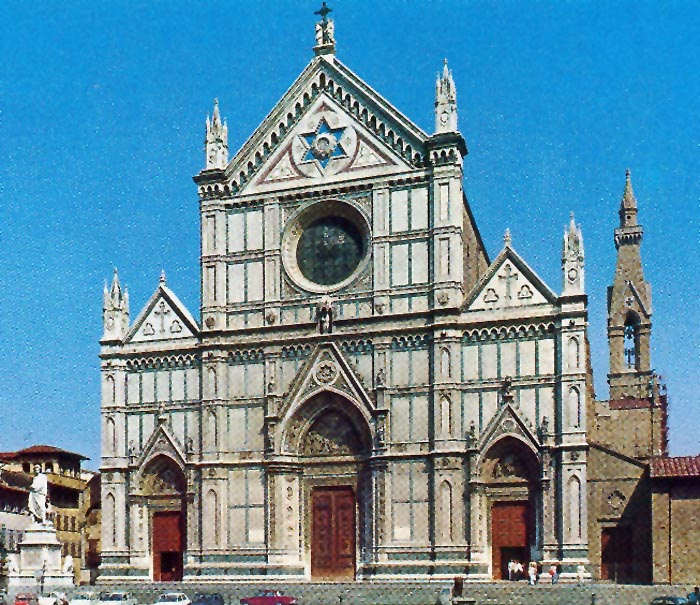 |
Church of Sante Croce - Renaissance The statues that decorate it are : by Giovanni Dupre, the Madonna, above the central portal and the Triumph of the Cross in the lunette below; by Zocchi is the Vision of constantine in the lunette of the right hand door; by tito Sarrocchi is the discovery of the Cross. The sandstone Gothic-style bell tower is Baccani (1874), on the left is the beautiful 14th century portico in the same style as the one on the right. To the left of the facade is the monument dedicated to Dante Alighieri, by enrico Pazzi (1865), originally encumbered the center of the square but was removed in May 1968. |
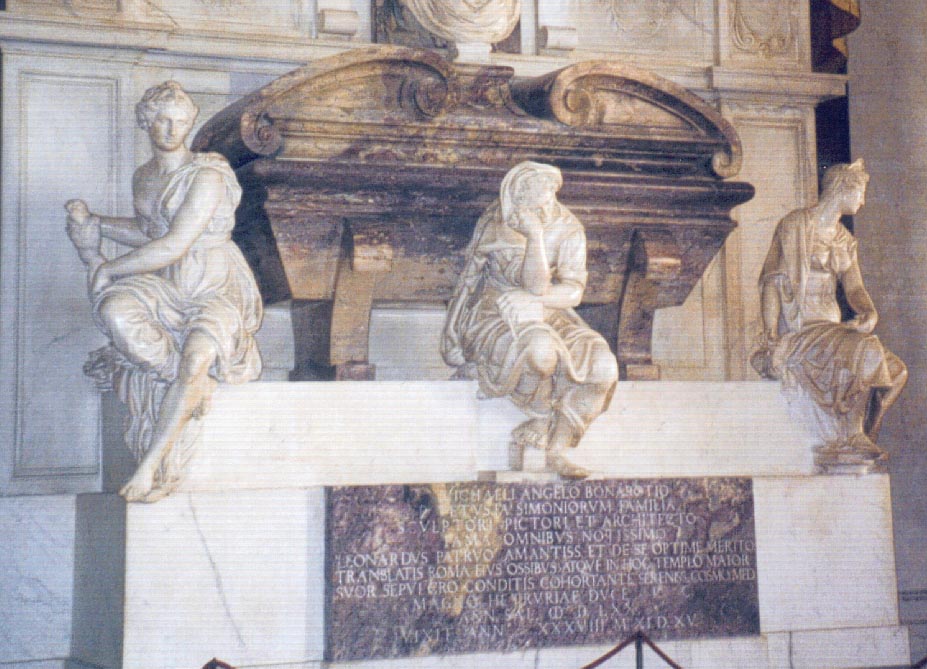 |
Church of Sante Croce - Renaissance In Sante Croce are buried many notable figures in history. This is the tomb of Michelangelo. Also buried here are Dante, Vittorio Alfieri, Machivelli, Lanzi, Donatello, Leonardo Bruni, gioacchino Rossini, Morghen, Carlo Marsuppini, and galileo Galilei. |
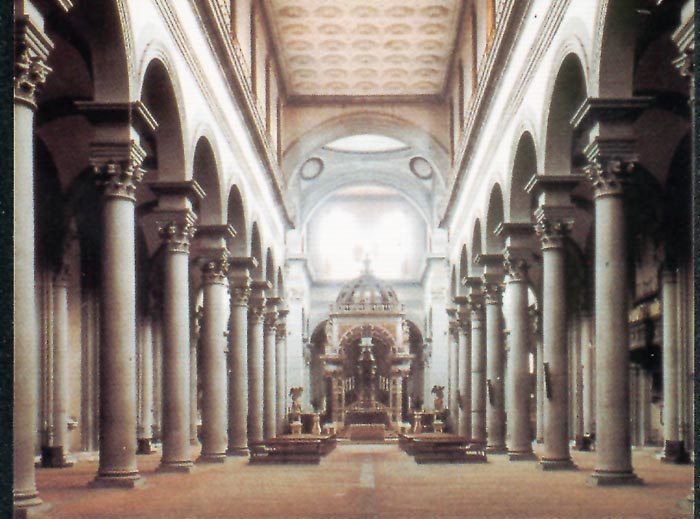 |
Santo Spirito - Renaissance The Curch of San Spirito was Brunelleschi's last creation. It was begun in 1444. It has a simple, geometric facade typical of the rennessance. simple, elegant, mathematical, and beautiful. |
 |
Santo Spirito - Renaissance The belltower is by Baccio d'Agnolo, the dome was by Salvi di Andrea following a design by Brunelleschi. The interior of the church is in the form of a latin cross with a nave and two aisles that continue in the transept with admirable proportions. Although Brunelleschi's original design underwent some alterantions, the church reflects his architectural concept based on the harmony of proportions and on the measured division of space. Along the walls of the church are 38 semi circular chapels contains the works of art. |
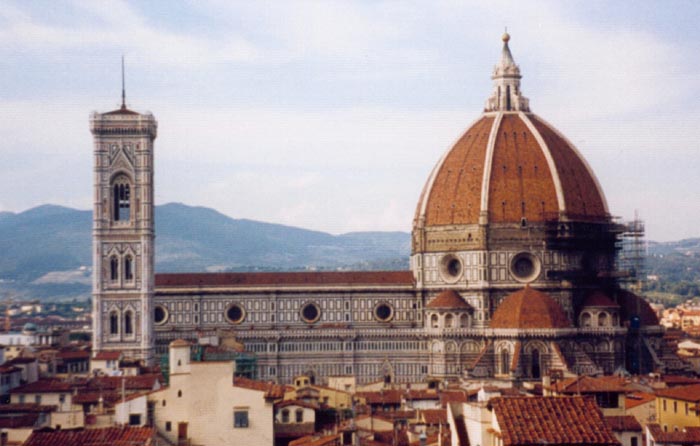 |
Santa Maria del Fiori
- Renaissance The Santa Maria Del Fiore (Saint Mary of the Flower) - Arnolfo di Cambio began the construction (1296) to replace the old church of St. Reparata. After Arnolfo's death in 1302, the work was continued by Giotto who died in 1337. Later 1357 Francesco Talenti and Giovanni di Lapo Ghini continued its construction, enlarging the original plan. in 1412, the name Santa Reparata was changed to Santa Maria del Fiore (St. Mary of the Flower), alluding to the Florentine fleur-de-lys. In 1436 when Brunelleschi completed the cupola, the Church was consecreated by Pope Eugenius IV. |
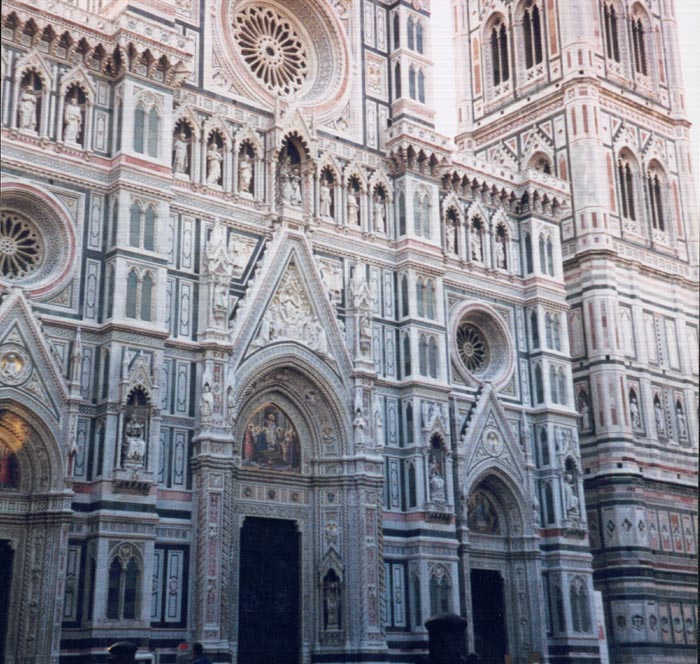 |
Santa Maria del Fiori
- Renaissance The decoration of the interior was supposed to be mosaic but was altered by Vasari and Zuccari who frescoed the pompous and manneristic Final Judgement. The stained glass windows at the base of the dome were made from cartoons by Donatello, Paolo Uccello, Ghiberti and Andrea del Castagno. |
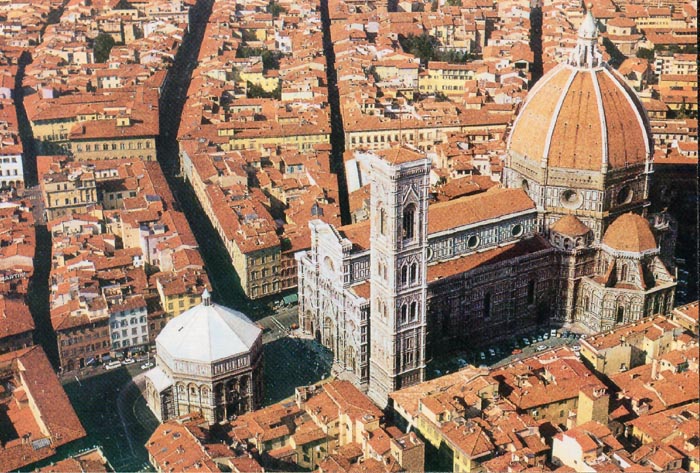 |
Santa Maria del Fiori
- Renaissance Brunelleschi, friend of the astronomer Toscanelli, after his profound mathematical studies and attentive observations of ancient buildings, especially the Pantheon in Rome, built the first cupola without use of the customary scaffolding. His creation is a double dome, the outer one having enormous ribs. Below, big robust pilasters around the tribune prepare the remarkable thrust of the cupola, that rises elegantly and majestically on high. |
 |
Santa Maria del Fiori
- Renaissance With machines of his own invention, Brunelleschi hauled the material to the top and built the octagonal cupola; two vaults separated by an air-space that solidly sustained by the play of weight and counter-weight, rises ever higher. |
 |
Vasari Corridor
- Renaissance The Vasari Corridor - following the construction of the Uffizi Museum, Cosimo I commissioned the Vasari corridor to be built. This was a "secret" corridor to connect the political center of the city with Palazzo Pitti (New PalacE), the new grand-ducal residence on the other side of the Arno River. The Vasari corridor is a raised passageway (about 1 km!) starting from the Uffizi and crossing the Arno above the Ponte Vecchio. The corridor houses a precious collection of self portraits from the 17th until the 20th century. |
 |
Medici Chapels - Renaissance The Medici chapel houses monuments to members of the Medici family. The funeral monuments were commissioned in 1520 by Pope Clement VII. These were mostly done by by Michelangelo from 1520 to 1534. They were then completed by Michelangelo's pupils after his departure. Monuments for the tombs of Lorenzo, Duke Di urbino, Giuliano, and Duke de Nemours are each a seated armed figure in a niche, with an allegorical figure reclining on either side. The seated figures, representing the two dukes, are treated as types. Lorenzo, whose Face is shaded by a helmet, personifies the reflective man; Giuliano, who is holding the baton of an army commander, portrays the active man. At his feet recline the figures of "Night" and "Day." "Night," a giantess; "Day," a herculean figure. The two companion figures of Lorenzo are "Dusk," and "Dawn." Lorenzo the Magnificent and his brother Giuliano the Elder were buried at the entrance wall, and over them was set up a marble group consisting of a "Madonna and Child". The "Madonna" is a work of imposing majesty, completed by Michelangelo. |
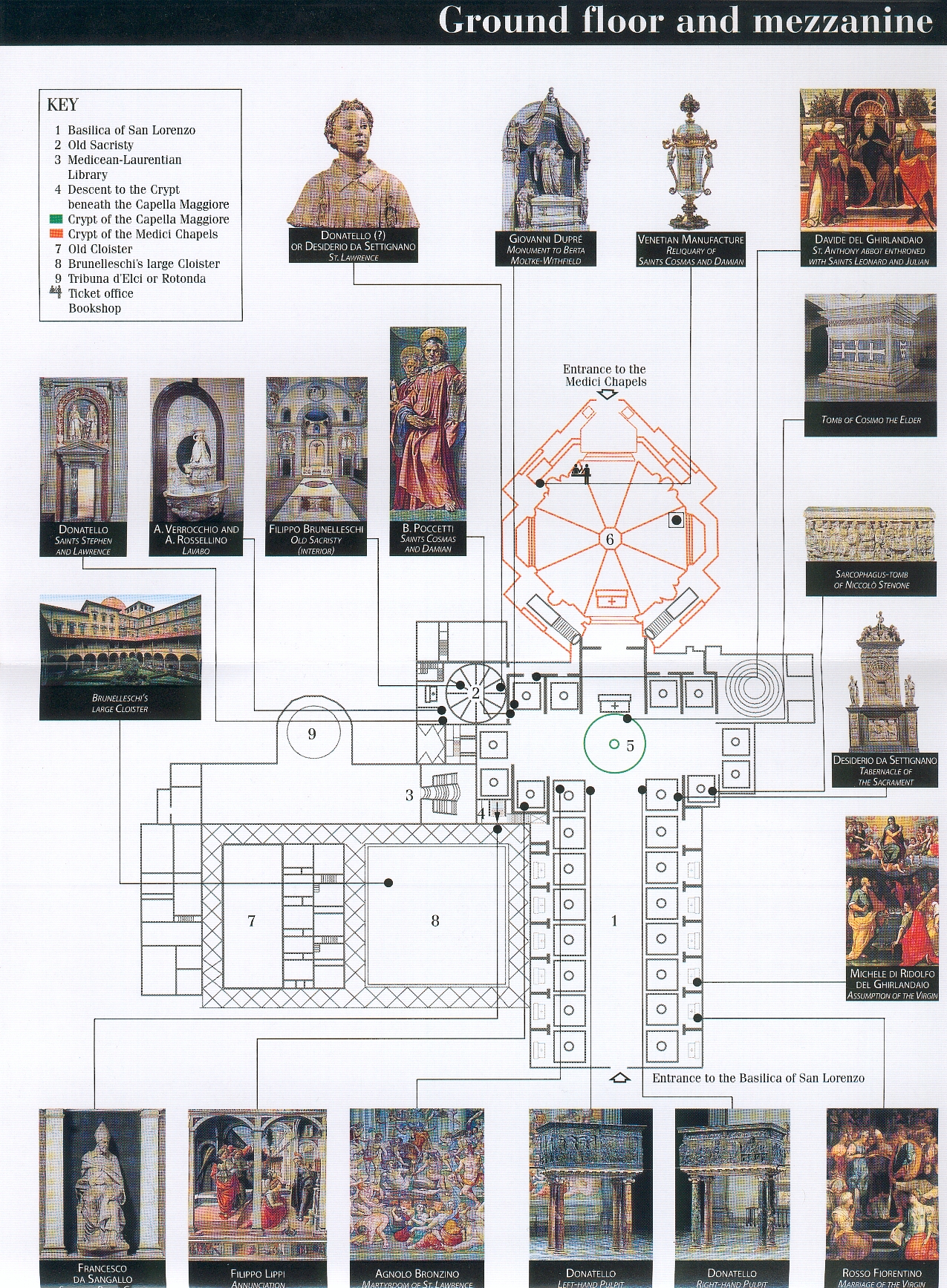 |
Medici Chapels - Renaissance A map of the Medici Chapel. |
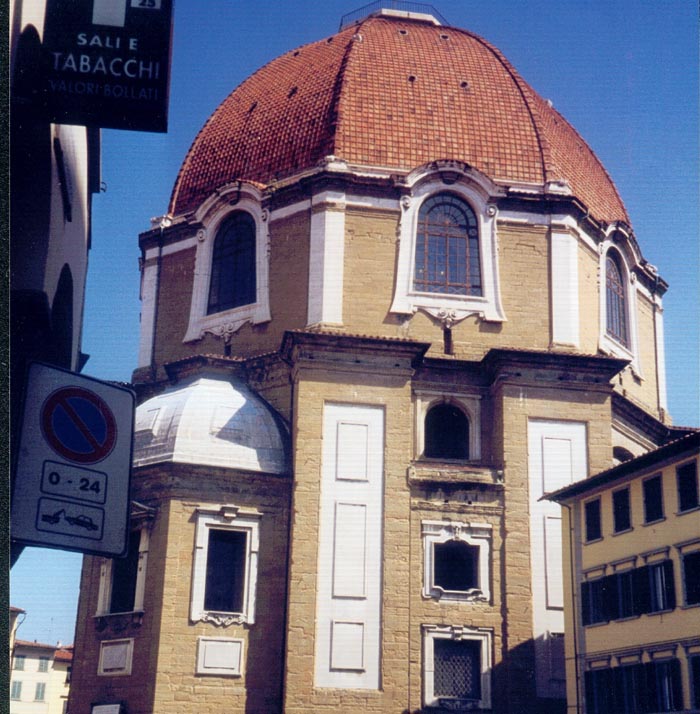 |
Medici Chapels - Renaissance Exterior view of the Medici Chapels. |
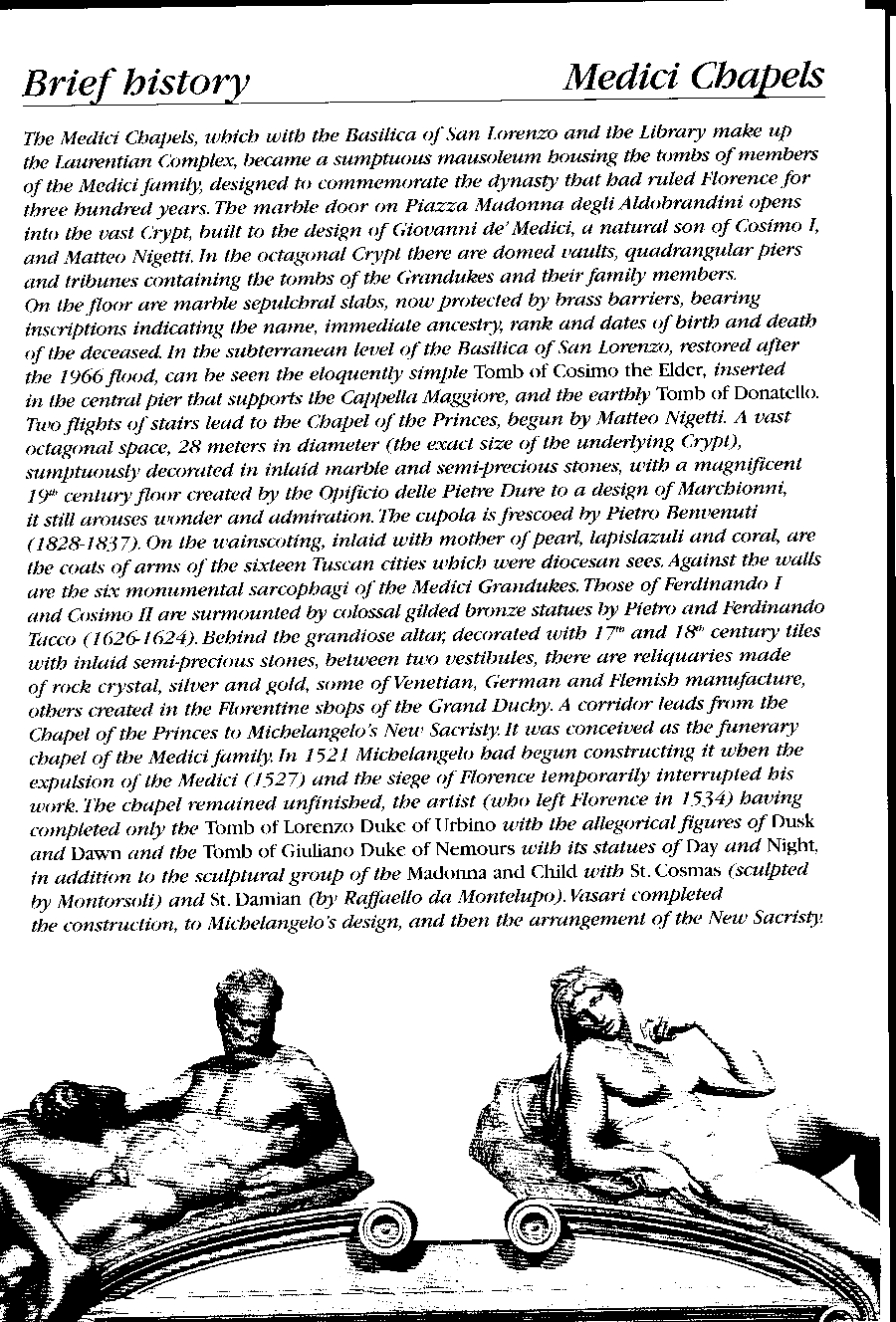 |
Medici Chapels - Renaissance The Medici Chapels - Descriptive brochure |
 |
Medici Chapels - Renaissance The Medici Chapels - Descriptive brochure |
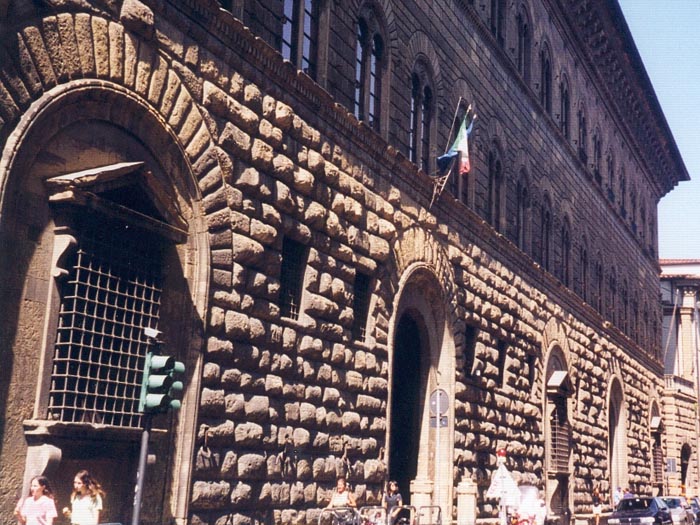 |
Medici Palace - Renaissance The Medici Palace - this splendid renaissance palace is an example of a wealthy person's home, was built by Michelozzo for cosimo the Elder. the facade, elegant and majestic with its stories of decreasingly rusticated ashlar, is finished at hte top with a splendid classical cornice. The beautiful mullioned windows became exmples for "Renaissance" architecture. Among the people who lived here were Cosimo the elder, Lorenzo the Magnificent and his successors, among whom was catherine dei Medici, the future Queen of France. Among the foreign Sovereigns were: Charles VIII of france, and charles V of spain. in 1655 the Medici moved their home to the Pitti Palace and sold this palace to the Riccardi family. |
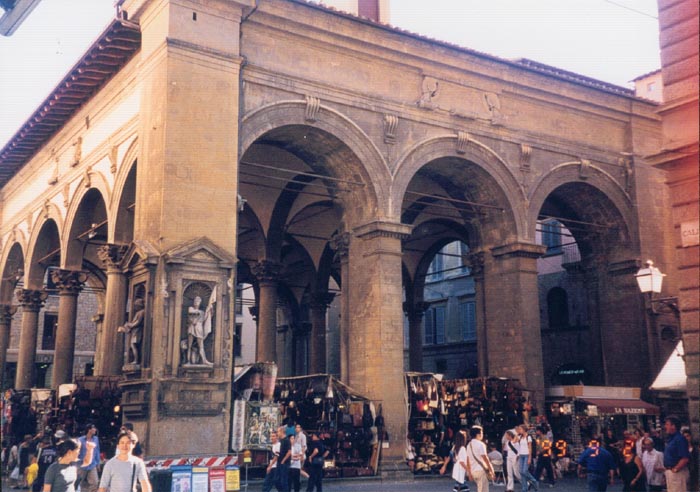 |
Mercato Nuovo - Renaissance Florentines call this market Il Porcellino (Little Pig) due to the wild boar fountain located at the market's south side. The statue, created in 1612 by Pietro Taccas, was cast from a marble Hellenistic original that is now housed in the Uffizi Gallery. Many tourists come to rub the pig's well-polished snout and throw a coin in the fountain. It is believed that by doing so it insures a return trip to Florence. The people of Florence have heavily used this markets in since Grand Duke Cosimo I had it built between 1547-1551. Designed by Giovanni Battista, it was initially used for the sale of silk and gold. In times of hostility, the city's medieval war cart was positioned here as warning of impending hostilities. The makret was also used as a place for public punishment. Dodgy merchants convicted of bankruptcy received a spanking before being sent to prison. |
 |
Via Del Tourbini
- Renaissance This marked the birth of modern Capitalism, with the invention of modern accounting practices arising in Florence. |
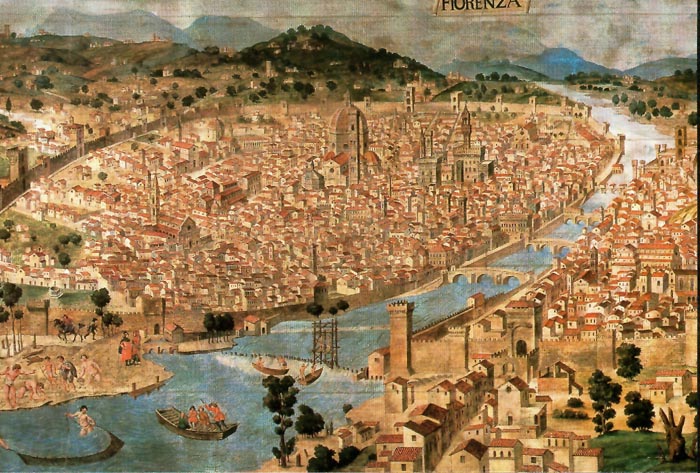 |
Florence - Renaissance This is a view of Florence in the Renaissance times. |
 |
Science Museum - Renaissance This amazing little science museum in Florence has some of the most astounding exhibits in the world. It holds Galileo's first telescopes for instance. It also holds some exhibits demonstrating science performed in the Renassance times. It is said that the three most influential inventions that led to the modern world were the compass, the use of gunpowder, and the telescope. The telescope changed Man's earth-centric view of a static universe into a heliocentric dynamic view. |
 |
Uffizi - Renaissance The Uffizi Gallery is about 8.000 sq.m. and contains one of the most important collections of art of all time. The Uffizi Gallery was the first museum to be opened to the public. |
 |
Uffizi - Renaissance The Grand duke granted permission to have visitors from 1591. The Uffizi Gallery is the oldest museum in the world. The museum contains classical sculpture and paintings on canvas and wood by 13th to 18th century artists. |
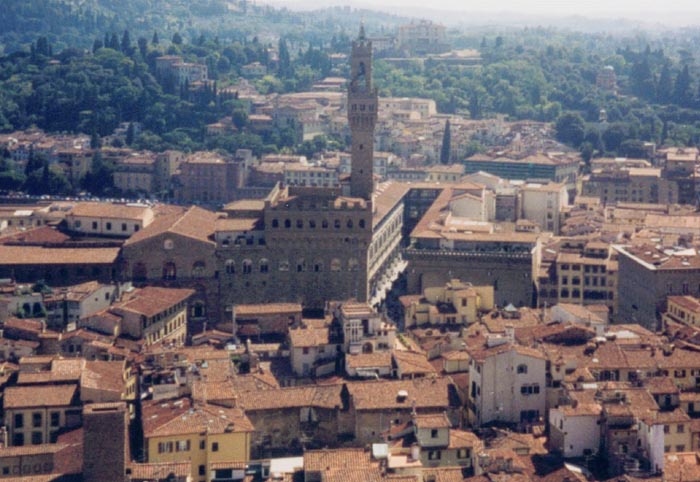 |
Uffizi - Renaissance Cosimo I de' Medici built the Palace, whose construction was started by Giorgio Vasari in 1560 and later completed by Buontalenti. He designed the Tribune, to house the administrative offices (or "uffizi") of the Government. The Palazzo Vecchio had become too small for that purpose. Cosimo's son, Francesco I was responsible turning the palace into a museum in 1581. The second floor of the Gallery was fitted with huge windows and set up the grand-ducal collection of classical statues, medals, jewellery, weapons, paintings and scientific instruments here. |
 |
Uffizi - Renaissance Albertinelli's Visitation in the Uffizi is a good example of Renassance art. |
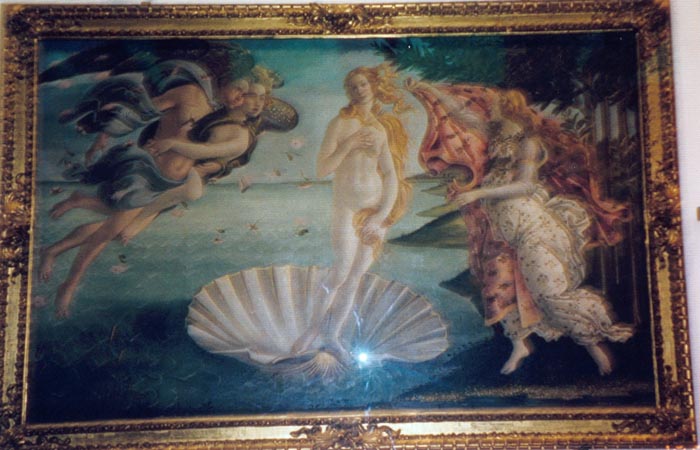
|
Uffizi - Renaissance Boticelli's Birth of the Venus in the Uffizi is one of the most famous paintings in the world. |
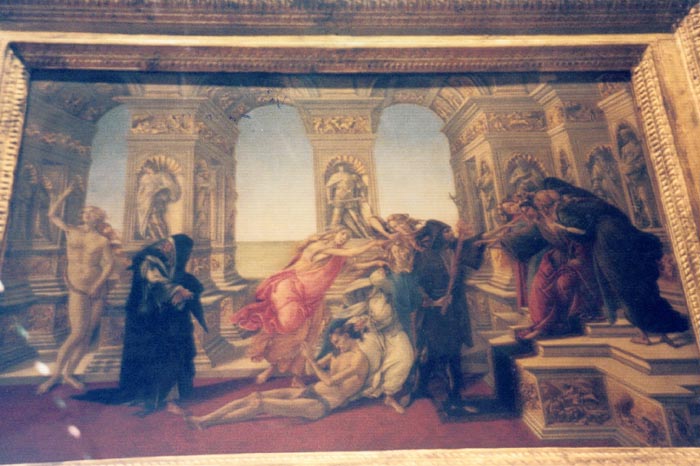 |
Uffizi - Renaissance Boticelli's calumny. |
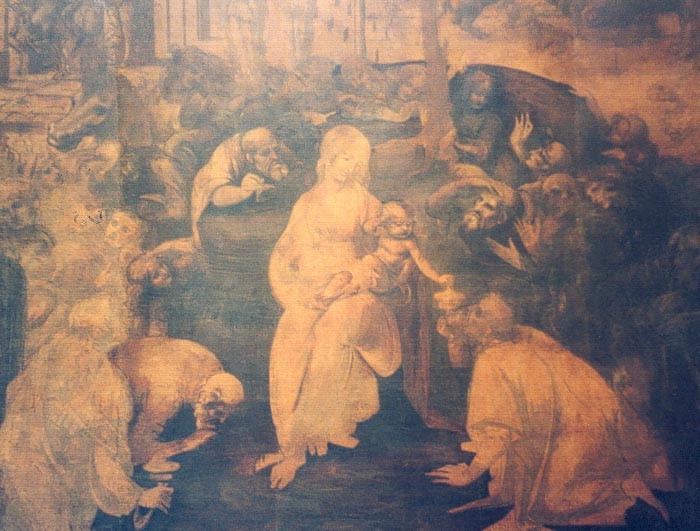 |
Uffizi - Renaissance The Ascension of the Magi by Leonardo da Vinci. The smoky quality of the painting is a technique called Sfumato. |
 |
Duomo - Renaissance This is the ceiling of the Duomo (Santa Maria del Fiore). It utilizes the techniques of perspective developed in the Renaissance that influenced modern drawing techniques. |
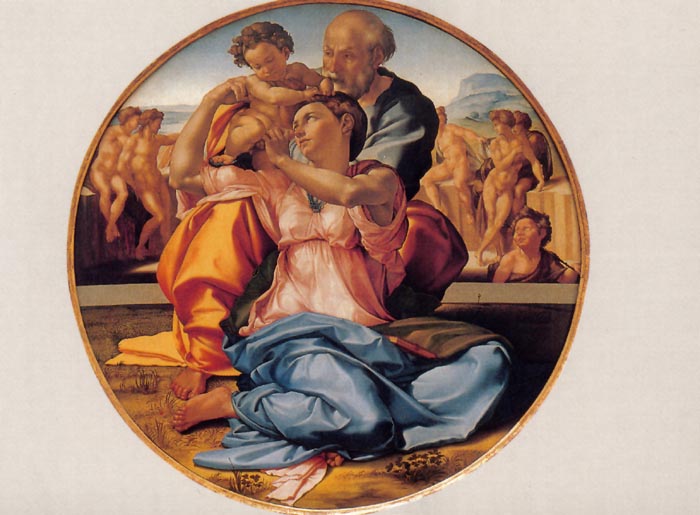 |
Uffizi - Renaissance This is the "Holy Family" painted by Michelangelo Michelangelo painted in the high Renassance. |
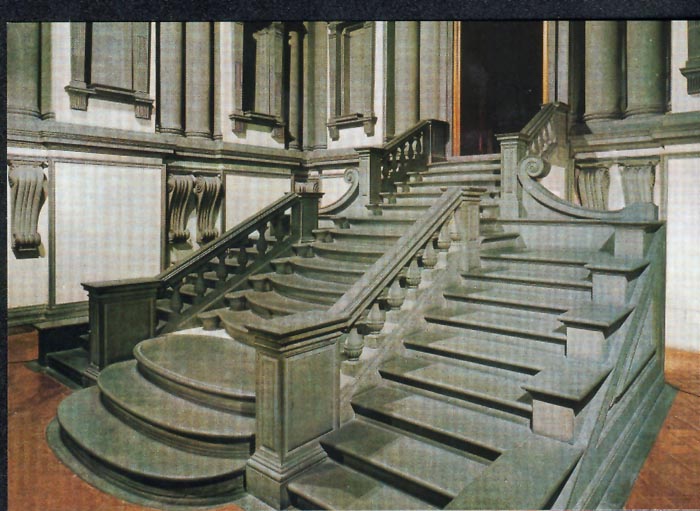 |
Uffizi - Renaissance Michelangelo's Staircase painting |
 |
Uffizi - Renaissance Raphael's Madonna Goldfinch. |
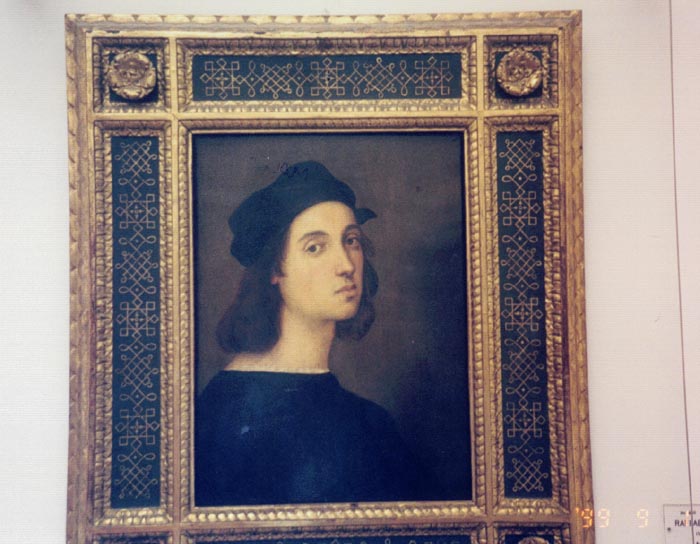
|
Uffizi - Renaissance raphael Sanzio's Self Portrait |
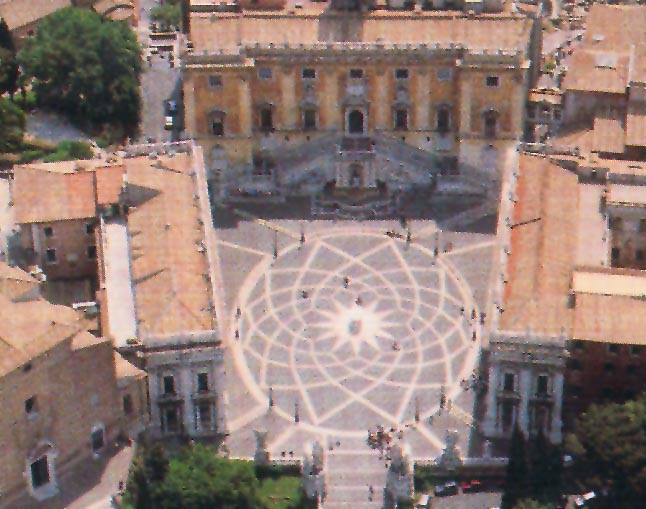 |
Campidoglio - Renaissance Piazza del Campidoglio - when Emperor charles V visited Rome in 1536, pope Paul III Farnese was so embarrassed by the muddy state of the Capitol that he asked Michelangelo to draw up plans for repaving the piazza and for renovating the facades of Palazzo dei Conservatori and Palazzo Senatorio. Michelangelo proposed adding the Palazzo Nuovo to form a piazza in the shape of a trapezium, embellished with Classical sculptures chosen for their relevance to Rome. |
 |
Campidoglio - Renaissance Building started on the Capidoglio in 1546 but progressed so slowly that Michelangelo only lived to oversee the double flight of steps at the entrance of Palazzo Senatorio. The piazza was completed in the 17th century, the design remaining largely faithful to the original. Pilasters two-stories high and balustrades interspersed with statues link the buildings thematically. The Piazza faces west toward St. Peter's , the Christian equivalent of the Capitol. At it center stands a replica of a statue of Marcus Aurelius. The original is in the Palazzo Nuovo. |
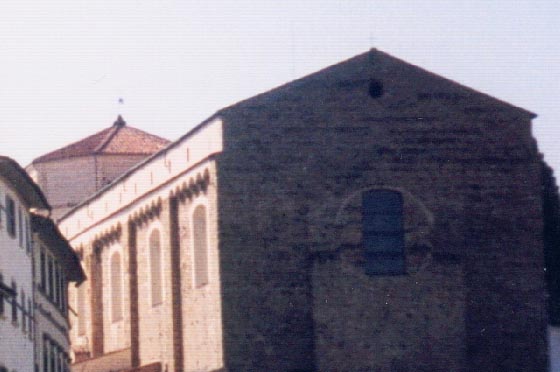 |
Brancacci Chapel
- Renaissance The Brancacci Chapel - is one of the most important symbols of the Italian Renaissance. The cycle of frescoes by Masolino da Panicale, continue by Masaccio and finished by Filippino lippi. By Masolino da Panicale, Masaccio's teacher, delicate painter of late gothic style who, in these frescoes, was certainly influenced by his young pupil Masaccio, we can admire: The Temptation of Adam and Eve, part of St. Peter healing the cripple and the Resuscitation of Tabitha. Masaccio continued alone after Masolino left for Hungary and, in opposition to the Temptation, represents the Expulsion of Adam and Eve with a new language. Among the most dramatic scenes of the Life of St. Peter is the celebrated Payment of the Tribute in which the young Masaccio surpasses his teacher in the powerful, monumental and vibrant figures. |
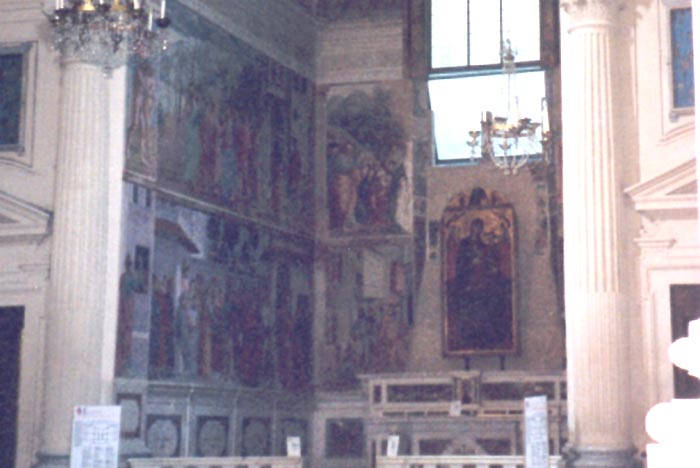 |
Brancacci Chapel
- Renaissance St. Peter healing the cripple - What makes the Brancacci Chapel so special is that the artists of the high renaissance learned the techniques of perspective and three dimensional painting from these very frescoes. They started a revolution in art that marked the inception of the Renaissance. They and other artists paved the way to are more mathematical, systematic, rational world that served as the underpinnings of the modern world. |
 |
Brancacci Chapel
- Renaissance A close up of St. Peter healing the cripple painting by Masaccio. |
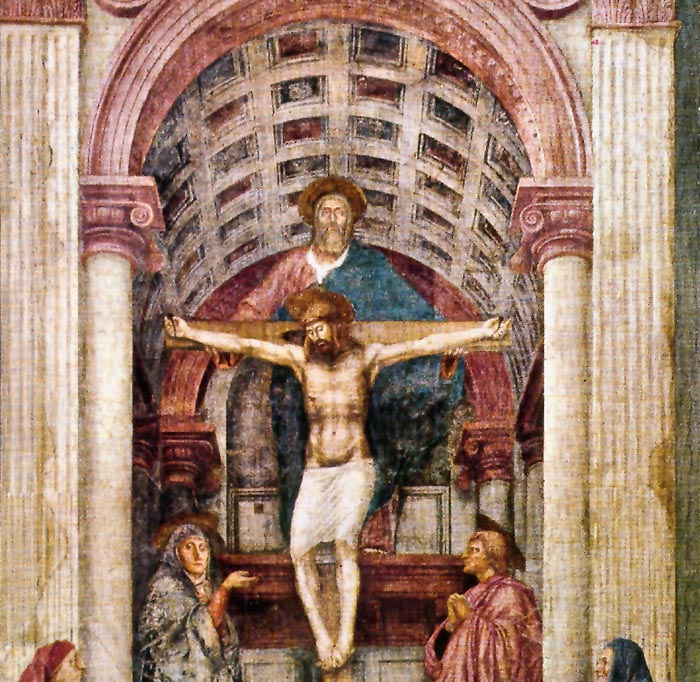 |
Masaccio - Renaissance Paintings by Masaccio - note the elements of dimensionality - perspective, horizon, depth, vanishing point, hue shifting are integrated to give a sense of body to the painting. |
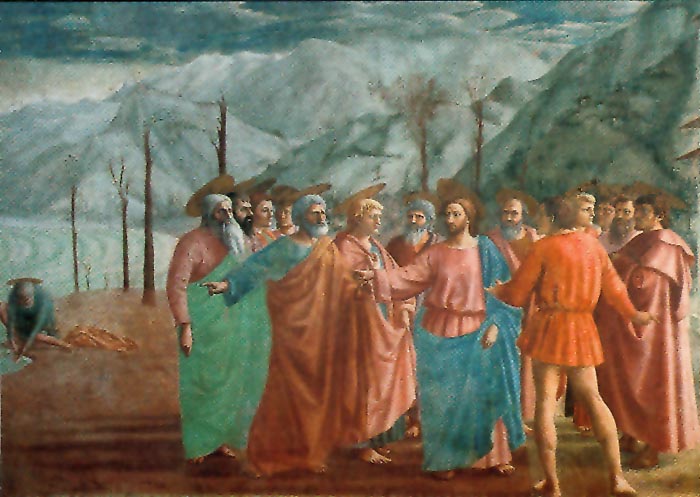 |
Masaccio - Renaissance Fresco by Masaccio |
 |
Raphael Rooms - Renaissance In 1514, Raphael is made the director of works for St. Peter's cathedral, and his "Raphael Rooms" sport his paintings. |
 |
Raphael Rooms - Renaissance There are a couple of bright vivid paintings (frescoes) that demonstrate the power of Renaissance techniques (that we take for granted today). These sets of paintings symbolize greek natural philosophers. Note that Gothic art, which precedes Renaissance art does not have the three dimensional aspects. Also consider that the paintings are not religious in content. Gothic art and art before the Renaissance was largely religious in topic. The renaissance celebrated the human spirit, the human form, and the will and power of human inginuity. |
 |
San Giovanni in Laterano
- Renaissance early in the 4th century, the Laterani family were disgraced and their land taken by Emperor constantine to build Rome's first christian basilica. Today's church retains the original shape but has been destroyed by fire twice and rebuilt. Borromini did the rebuild in 1646, and the facade is an 18th century addition. Before the pope's move to Avignon in 1309 , the adjoining Lateran Paalace was the official papal residence, and until 1870 all popes were crowed in the church. The pope is the Bishop of rome, and here in the city's main cathedral he celebrates Maundy thursday mass and attends the annual blessing of the people. |
 |
Santa Maria del Popolo
- Renaissance Santa Maria del Popolo - one of Rome's greatest stores of artistic treasures, this early Renaissance church was commissioned by Pope Sixtus IV della Rovere in 1472. Among the artists who worked on the building were andrea Bregno and Pinturicchio. Later additions were made by Bramante and Bernini. Many illustrious families have chapels here, all decorated with appropriate splendor. The Della rovere Chapel has delightful pinturicchio frescoes. The fines of all is the Chigi Chapel designed by Raphael for his patron, the banker Agostino Chigi. |
 |
Santa Maria del Popolo
- Renaissance what makes this church significant in Renaissance history is that Martin Luther visited this church, and was so taken aback by the corruption in the church, and the selling of indulgences, that he posted his 95 theses here. this sparked a revolution in thinking, and he advocated returning to the basics. Having people read and learn from the bible directly, for themselves. |
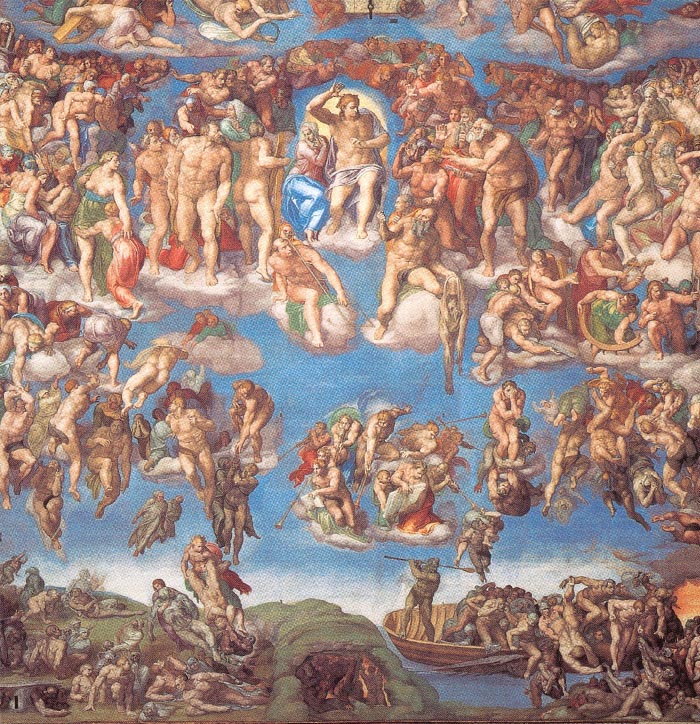 |
Sistine Chapel - Renaissance This is the ceiling of the Sistine Chapel painted by Michelangelo. Michelangelo frescoed the chapel ceiling for Pope Julius II between 1508 and 1512. Refusing assistance, he worked alone on specially designed scaffolding. The subjects are from the Old testament in the Bible. Except for the classical sibyls, who appear because they were said to have prophesied the birth of Christ. |
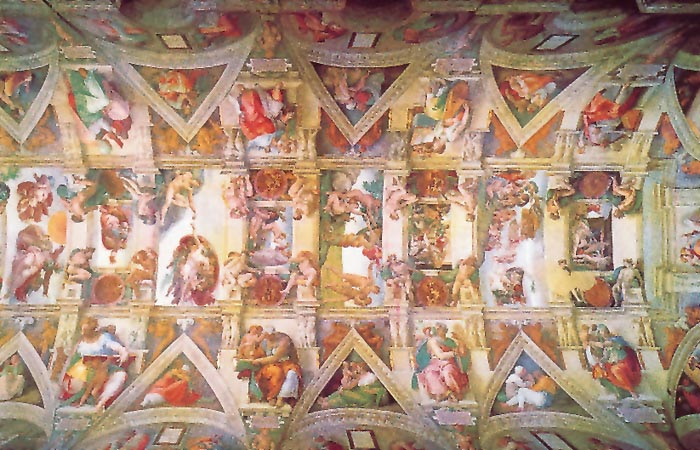 |
Sistine Chapel - Renaissance A broad view of the Sistine chapel ceiling. |
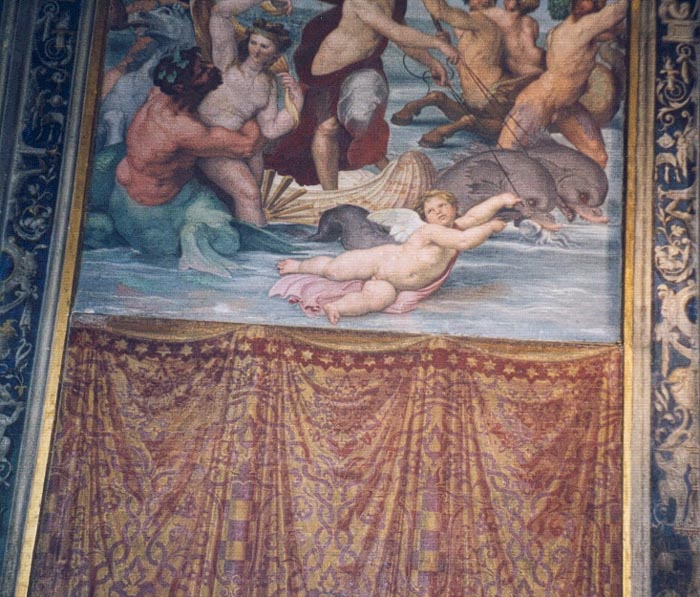 |
Villa Farnesina - Renaissance The wealthy sienese banker Agostino Chigi, commissioned the villa in 1508. With a central block and projecting wings, this was one of the earliest true Renaissance villas. The decoration was carried out betwen 1510 and 1519, and this has recently been restored. Sebastiano del piombo, Raphael and his pupils added more elaborate works. The frescoes illustrate Classical myths and the vault of the main hall, the Sala di galatea is adorned with scenes showing the position of the stars at the time of chigi's birth. Artists, poets, princes, cardinals and the pope himself were entertained here in style by their wealthy host. In 1577 the villa was bought by Cardinal Alessandro Farnese. Since then it has been known as villa Farnese. |